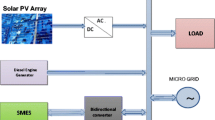Abstract
The frequency of the power system varies based on the load pattern of the consumers. With continuous increase in the load, the frequency of the system keeps decreasing and may reach its minimum allowable limits. Further increase in the load will result in more frequency drop leading to the need of load shedding, if excess generation is not available to cater the need. This paper proposed a methodology in a hybrid thermal-hydro system for finding the required amount of load to be shed for setting the frequency of the system within its minimum allowable limits. The load shedding steps were obtained based on the rate of change of frequency with the increase in the load in both areas. The impact of superconducting magnetic energy storage (SMES) was obtained on load shedding scheme. The comparison of the results was presented on the two-area system.
Similar content being viewed by others
References
Thompson J G, Fox B. Adaptive load shedding for isolated power systems. IEEE Proceedings of Generation, Transmission and Distribution, 1994, 141(5): 491–496
Concordia C, Fink L H, Poullikkas G. Load shedding on an isolated system. IEEE Transactions on Power Systems, 1995, 10(3): 1467–1472
Anderson P M, Mirheydar M. A low-order system frequency response model. IEEE Transactions on Power Systems, 1990, 5(3): 720–729
Anderson P M, Mirheydar M. An adaptive method for setting under frequency load shedding relays. IEEE Transactions on Power Systems, 1992, 7(2): 647–655
Maliszewski R M, Dunlop R D, Wilson G L. Frequency actuated load shedding and restoration Part I-Philosophy. IEEE Transactions on Power Apparatus and Systems, 1971, PAS-90(4): 1452–1459
Horowitz S, Polities A, Gabrielle A. Frequency actuated load shedding and restoration art II-Implementation. IEEE Transactions on Power Apparatus and Systems, 1971, 90(4): 1460–1468
Rudez U, Mihalic R. Monitoring the first frequency derivative to improve adaptive underfrequency load-shedding schemes. IEEE Transactions on Power Systems, 2011, 26(2): 839–846
Lokay H E, Burtnyk V. Application of under-frequency relays for automatic load shedding. IEEE Transactions on Power Apparatus and Systems, 1968, PAS-87(5): 1362–1366
Chuvychin V N, Gurov N S, Venkata S S, Brown R E. An adaptive approach to load shedding and spinning reserve control during under-frequency conditions. IEEE Transactions on Power Systems, 1996, 11(4): 1805–1810
Shilling S R. Electrical transient stability and under-frequency load shedding analysis for a large pump station. IEEE Transactions on Industry Applications, 1997, 33(1): 194–201
Kottick D, Or O. Neural-networks for predicting the operation of an under-frequency load shedding system. IEEE Transactions on Power Systems, 1996, 11(3): 1350–1358
Elgerd O I, Fosha C E. Optimum megawatt frequency-Control of multi-area electric energy systems. IEEE Transactions on Power Systems, 1970, PAS-89(4): 556–563
Giroletti M, Farina M, Scattolini R. A hybrid frequency/power based method for industrial load shedding. Electric Power and Energy Systems, 2012, 35(1): 194–200
Abraham R J, Das D, Patra A. Automatic generation control of an interconnected hydrothermal power system considering superconducting magnetic energy storage. International Journal of Electrical Power & Energy Systems, 2007, 29(8): 571–579
Author information
Authors and Affiliations
Corresponding author
Rights and permissions
About this article
Cite this article
Tyagi, D., Kumar, A. & Chanana, S. Load shedding scheme for an interconnected hydro-thermal hybrid system with SMES. Front. Energy 6, 227–236 (2012). https://doi.org/10.1007/s11708-012-0198-6
Received:
Accepted:
Published:
Issue Date:
DOI: https://doi.org/10.1007/s11708-012-0198-6




